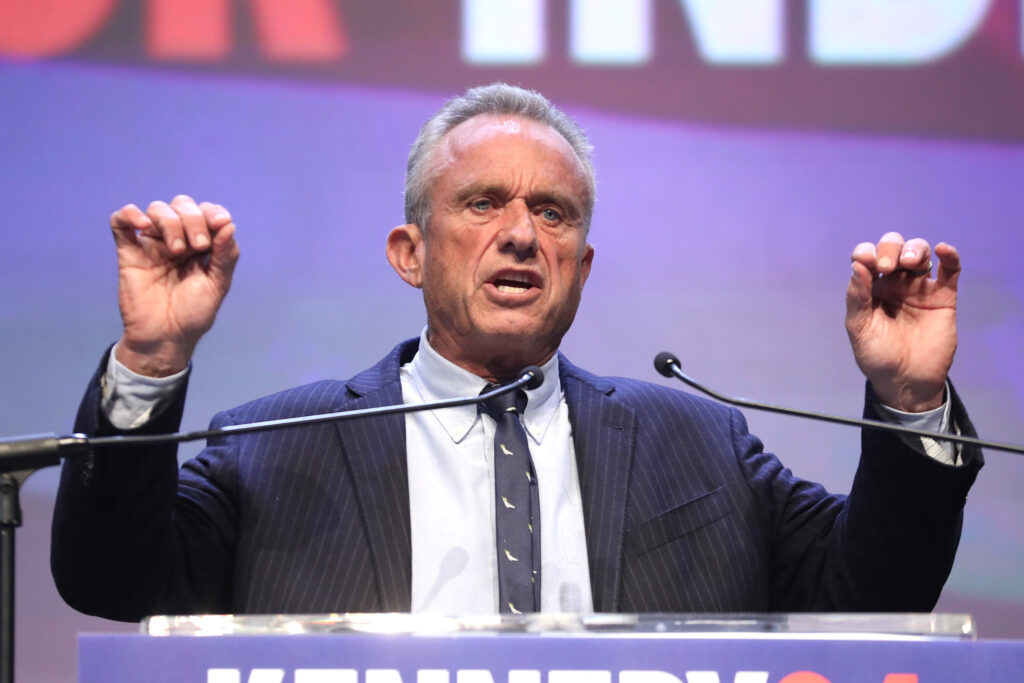Thanksgiving, turkey and – tartrazine? Why RFK’s nomination as HHS secretary is making waves this holiday season
Traditional retellings of the first Thanksgiving highlight Squanto, the Native American who helped the Pilgrims survive in a new land by teaching them how to fish, hunt and plant corn.
Now…

Traditional retellings of the first Thanksgiving highlight Squanto, the Native American who helped the Pilgrims survive in a new land by teaching them how to fish, hunt and plant corn.
Now 404 years later, Trump’s pick for Health and Human Services secretary, Robert F. Kennedy Jr., wants to help Americans survive in a different way – by removing toxins in the foods we eat year-round.
“Restaurants that serve contaminated food are fined or shut down,” he says in a new video, “but when it’s the government that approves the poisons in our food, a few people get very, very rich, and the toxins end up in every supermarket aisle.”
Kennedy targeted one food additive – tartrazine, or yellow dye #5 – used to color a wide range of “low-quality foods” such as corn, mustard, and other items likely featured on Thanksgiving tables. Health risks include tumors, asthma, ADD/ADHD, anxiety and other neurological damage, according to the video.
“It’s crazy to add this to your kid’s favorite foods. It doesn’t even change the flavor,” Kennedy argues, noting yellow dye #5 is originally derived from coal tar and is restricted in other countries outside the U.S.
“I’ve been picking on tartrazine today, but that’s just one of at least 100 chemical poisons that our health agencies allow into our children’s food.”
‘Public health collapse’
Kennedy’s nomination caused a furor among left-leaning legacy media outlets, with CNN calling him “one of the nation’s most prominent anti-vaccine conspiracy theorists” and NPR dismissing several of his previous claims as “baseless.”
However, even these critics admit his “Make America Healthy Again” movement has garnered bipartisan support.
“MAHA has set its sights on big food and big pharma, arguing that these industries use lobbying power to maximize profits at the expense of the country’s health,” NPR wrote. “This message served as an animating force in the final stretch of the election, as Kennedy elevated concerns about ultra-processed foods and poor nutrition, food additives, pesticides and toxic chemicals, and the harms of industrial agriculture, among other issues.”
Part of Kennedy’s popularity stems from widespread recognition of failures within the current health system, says Calley Means, Kennedy’s adviser and a former food-and-drug industry lobbyist.
“The public health expert class has given us a public health collapse,” he told NPR. “We are on the verge of, at best, a health crisis and, at worst, a societal collapse with 20% of GDP going to health expenditures. [We’re] getting sicker, fatter, more depressed, more infertile for every dollar we spend.”
Means also cites conflicts of interest between industry and government, such as pharmaceutical companies paying Food and Drug Administration fees and advisory panelists receiving funds from the industries they’re supposed to regulate.
“Despite the media’s effort to silo this movement into fringe areas like vaccines or fluoride or things like that, the voters saw very clearly that big ideas were being talked about,” Means maintains. “I think a spiritual connection was hit.”
Other ‘seismic changes’ in promised reforms
Kennedy described “three instructions” from President-elect Trump in an interview with NPR:
“He wants the corruption and the conflicts out of the regulatory agencies. He wants to return the agencies to the gold standard: empirically-based, evidence-based science and medicine that they were once famous for. And he wants to end the chronic disease epidemic with measurable impacts on a diminishment of chronic disease within two years.”
Both critics and advocates of Trump’s nominee acknowledge this represents a significant opportunity for reforming the healthcare and food industries.
“A real litmus test about whether or not they’re serious is whether they take on some of the economic interests that are causing our chronic disease epidemic,” says Dr. Tom Frieden, president and CEO of Resolve to Save Lives and former director for the Centers for Disease Control and Prevention.
NPR described Kennedy’s to-do list as “ambitious” with “seismic changes, from day one, including firing hundreds of staffers and scientists.
“Overhauling dietary guidelines, reforming federal programs that pay for ultra-processed foods, taking on crop subsidies, potentially banning pesticides and chemicals are just some of the priorities Kennedy outlined during the campaign.”
Many of these proposals had previously failed to gain any major traction after pushback from the food industry. For example, Dr. Mark Hyman – founder of the Cleveland Clinic Center for Functional Medicine and co-founder of Function Health – has called for reforms to the current system for years.
“I think this is a unique opportunity,” Hyman said, “because Trump is a burn-down-the-house kind of guy. Bobby is not looking for incremental change.”
In his new role, Kennedy would also oversee government programs such as Medicare, Medicaid and the Affordable Care Act, known colloquially as Obamacare.
“Though Trump has moved away from seeking to fully repeal Obamacare, it remains to be seen whether he and his health officials will release a plan to improve the law, as Trump promised on the campaign trail,” CNN reported.
Even in the first few weeks following his selection, Kennedy had already caused upheaval within the establishment. On the day his nomination was announced, vaccine makers such as Pfizer, Moderna and Novavax saw their shares plummet in value.
Meanwhile, parents who share Kennedy’s concern over food additives continue to spread awareness online and through social media.
“These ingredients offer no nutritional benefits and won’t improve shelf life,” writes Delishably.com ‘s Ginny – a mom who was shocked to find she had been feeding her son quantities of tartrazine in his macaroni-and-cheese school lunches.
After more research, she discovered at least seven other items in her house containing yellow dyes #5 and 6 – not counting the children’s multivitamins she had previously thought safe.
“If there is no nutritional value to this coloring, then why on earth put it in a multivitamin targeting children? Isn’t this the part of the population that may be sensitive to this dye?” she argued. “Little did I know that what I was forcing him to take might be harming him instead.”
For Ginny, the risks of these additives far outweigh any potential benefits.
“Several countries have banned them outright, and others are in the process of reducing the allowable quantities,” she noted, citing the UK, Norway, Germany and Austria. “So why should we keep feeding them to our families?”



